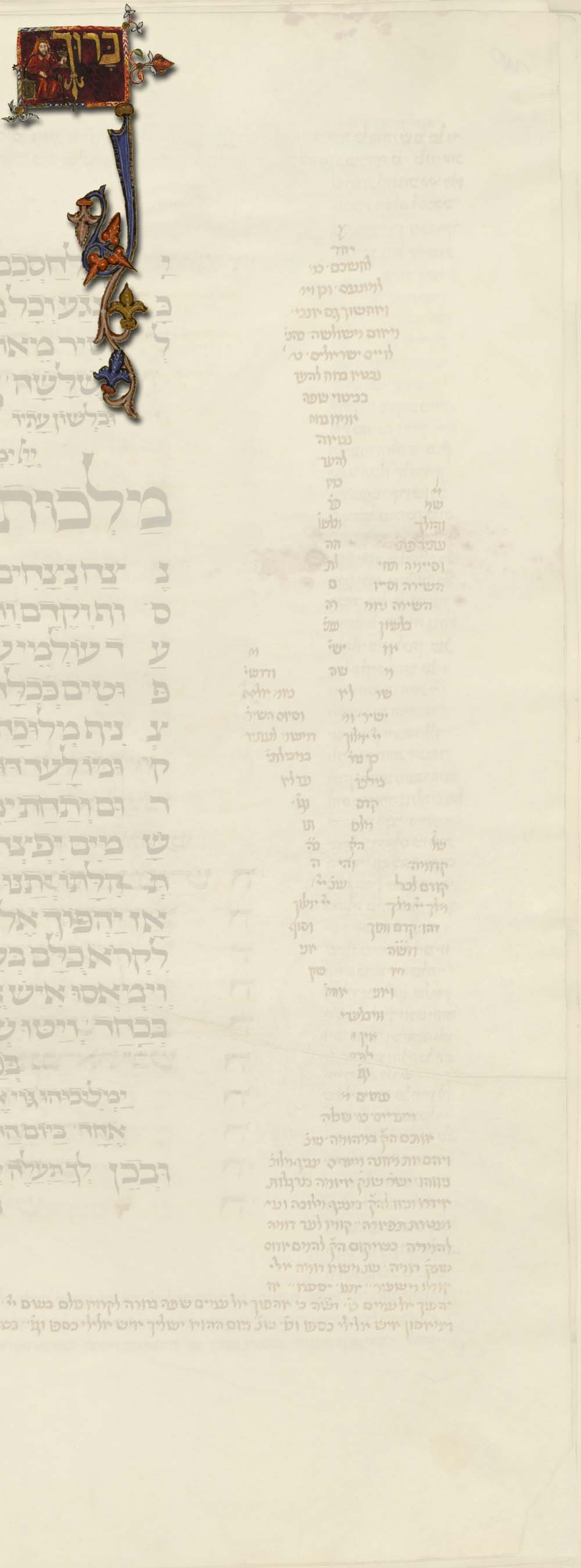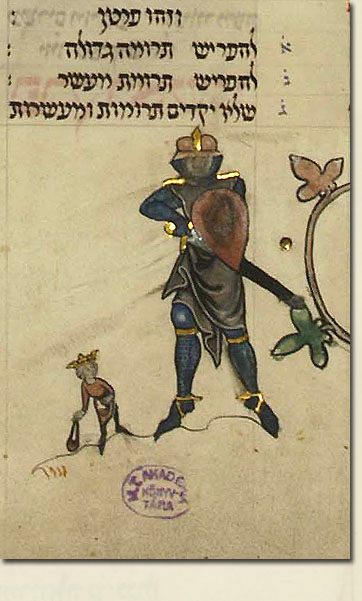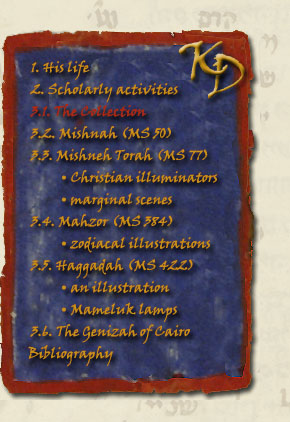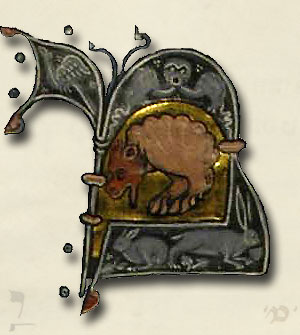



 3.1.
The Kaufmann Collection
3.1.
The Kaufmann Collection
 David
Kaufmann was a passionate collector
of manuscripts and books, for which the necessary material background was
provided by his wife and her family.
Schmelzer draws our attention to an interesting letter by
Kaufmann to
Berliner from which it appears
clearly that the necessary sums of money were put at his disposal by his wife in
every single case, and not always to the extent he may have wished. 56
It can also be mentioned that the famous luxurious illuminated manuscripts for
which his collection is so famous were never part of it actually: they were in
the possession of his mother-in-law, Mrs. Róza
Gomperz, who donated them to the
Academy herself together with the collection of her son-in-law. 57
In all probability, the price of these items may have been so high that
not even the funds at the disposal of the wife were sufficient and so
the passionate collector had to ask the help of his this mother-in-law,
who complied with his request but retained the ownership of these
precious items, probably as a sort of assurance. Upon his sudden death the collection
passed to his widow, who commissioned Max (Miksa)
Weisz (1872-1931), one of
Kaufmann's favourite students and
an intimate friend of the family, 58
to prepare a catalogue raisonné meeting scholarly demands. The splendid
catalogue was prepared and has rendered
David
Kaufmann was a passionate collector
of manuscripts and books, for which the necessary material background was
provided by his wife and her family.
Schmelzer draws our attention to an interesting letter by
Kaufmann to
Berliner from which it appears
clearly that the necessary sums of money were put at his disposal by his wife in
every single case, and not always to the extent he may have wished. 56
It can also be mentioned that the famous luxurious illuminated manuscripts for
which his collection is so famous were never part of it actually: they were in
the possession of his mother-in-law, Mrs. Róza
Gomperz, who donated them to the
Academy herself together with the collection of her son-in-law. 57
In all probability, the price of these items may have been so high that
not even the funds at the disposal of the wife were sufficient and so
the passionate collector had to ask the help of his this mother-in-law,
who complied with his request but retained the ownership of these
precious items, probably as a sort of assurance. Upon his sudden death the collection
passed to his widow, who commissioned Max (Miksa)
Weisz (1872-1931), one of
Kaufmann's favourite students and
an intimate friend of the family, 58
to prepare a catalogue raisonné meeting scholarly demands. The splendid
catalogue was prepared and has rendered
 great service to the scholarly community
ever since, but the widow did not live to see its publication: Katalog der
hebräischen Handschriften und Bücher in der Bibliothek des Professors Dr. David
Kaufmann s[eligen]
A[ndenkens] beschrieben von
Dr. Max Weisz. Frankfurt am Main
1906. 199+80 pp. The catalogue was written in German. However, it also appeared
with a Hungarian title-page and foreword with the body of the catalogue in
German. This edition bears an imprint indicating Budapest as the place of
publication. Incidentally, both editions were printed in Hungary by Adolf
Alkalay and Son, Pozsony: 59
Néhai Dr. Kaufmann Dávid tanár könyvtárának héber kéziratai és könyvei.
Összeállítja és ismerteti Dr. Weisz Miksa. Budapest 1906. 60
great service to the scholarly community
ever since, but the widow did not live to see its publication: Katalog der
hebräischen Handschriften und Bücher in der Bibliothek des Professors Dr. David
Kaufmann s[eligen]
A[ndenkens] beschrieben von
Dr. Max Weisz. Frankfurt am Main
1906. 199+80 pp. The catalogue was written in German. However, it also appeared
with a Hungarian title-page and foreword with the body of the catalogue in
German. This edition bears an imprint indicating Budapest as the place of
publication. Incidentally, both editions were printed in Hungary by Adolf
Alkalay and Son, Pozsony: 59
Néhai Dr. Kaufmann Dávid tanár könyvtárának héber kéziratai és könyvei.
Összeállítja és ismerteti Dr. Weisz Miksa. Budapest 1906. 60
Following the untimely death of
Kaufmann's widow on 19 June 1905, the collection passed to her mother, Mrs. Róza
Gomperz. “In accordance with the
intentions of the deceased” she donated the priceless collection to the
Hungarian Academy of Sciences “in perpetuity” in a donation deed dated 24
December 1905. 61
In its session of 29 January 1906 the Academy “commissioned the Presidency to
inform
 Madame Róza Gomperz of the
deep gratitude of the Academy”. She was also awarded the golden cross of
distinction (arany érdemkereszt) by Emperor Franz Joseph I for her
generous deed. 62
Family tradition has it that the choice fell upon the Academy because they
wanted to see the priceless collection in the most prestigious scholarly
institution – “in our foremost scholarly institute” as the words of the deed
express it.
Madame Róza Gomperz of the
deep gratitude of the Academy”. She was also awarded the golden cross of
distinction (arany érdemkereszt) by Emperor Franz Joseph I for her
generous deed. 62
Family tradition has it that the choice fell upon the Academy because they
wanted to see the priceless collection in the most prestigious scholarly
institution – “in our foremost scholarly institute” as the words of the deed
express it.
After all, it would have seemed plausible to donate the collection to the Rabbinical Seminary since Kaufmann had been working there and since the Seminary itself was one of the foremost institutions of its kind in the world in those times. According to information supplied by Dr. Béla Bakonyi it was his grandfather, Mr. Ludwig (Lajos) König, who played a key role in the donation process convincing Mrs. Róza Gomperz that the Academy was more prestigious than the Seminary. (König was married to Kaufmann's sister, Mrs. Róza Kaufmann.) Another tradition, related by Alexander Scheiber, has it that the choice was made upon Ignaz Goldziher's advice. 63 In any case, maybe it was this choice which saved the collection for future generations: soon after the German occupation of Hungary in March 1944 Adolf Eichmann paid a visit to the Seminary and removed a few thousand books. 64 It is beyond doubt that he would have included this famous collection in his selection if it had been there.
It was the König family who preserved Kaufmann's vast correspondence in several chests in the attic of their house at 93 Szondi street. Until his death in 1938 Ludwig (Lajos) König used to classify the letters. When the family moved to a smaller flat in a modern apartment house the mother, Margit König, had built at 18 Vitéz street in the Víziváros (Watertown) quarter of Buda in 1938, they left the correspondence behind because there was no place for it in the new house. Around 1941 it was destroyed when civilian defence regulations were passed prohibiting the preservation of combustible material in the attics of houses for the duration of the war – this the concierge told Margit König after the end of the war in 1945, when she inquired about Kaufmann's correspondence. In any case, the invaluable letters and notes disappeared without a trace. There can be no doubt that they were destroyed.
According to contemporary press reports, a “very large number” of printed books in Kaufmann’s possession was acquired by the “very smart” local antiquarian bookseller Schlesinger, 65 who sold them partly to the Seminary and partly to various private individuals so that a considerable number of them even reached the Vienna bookmarket. Allegedly by a misunderstanding, Schlesinger started selling off these items to individuals before the Seminary could acquire everything it wanted. Copies of Kaufmann’s own works including numerous off-prints bearing marginal notes in his familiar handwriting were offered for sale in large numbers, partly in Budapest and partly in Berlin. 66
It is often asserted that Kaufmann himself or his wife donated the collection to the Academy or that it was in accordance with his or their intentions that his mother-in-law offered it to this prestigious institution. The former statement is of course a mistake and, to my knowledge, no proof has ever been found to substantiate the latter – the passage in Mrs. Gomperz’s donation deed is perhaps simply a pious rhetorical device. Maybe after the sudden death of her husband Kaufmann’s wife was already considering the eventual future of the collection, but it has to be assumed that during his lifetime Kaufmann himself was simply not occupied with this question: after all, he belonged to the peculiar species of passionate collectors and although he did have health problems, he was only forty-seven when he died quite unexpectedly – we know that he was full of plans when he arrived at Karlsbad two days before the fatal accident.
62 On this distinction see the entry
Arany érdemkereszt. In: Révai nagy lexikona. Budapest
1911-1935. II. 5b.
63 Alexander
Scheiber: The Kaufmann
Haggadah. Budapest 1957. 4.
64
Frojimovics –
Komoróczy – Pusztai –
Strbik 1999. 207.
65 The
Schlesinger publishing
house and book-store was located at 1 Király street. The company moved
to Tel-Aviv in the late 1930s, where it has been active ever since. See
Frojimovics – Komoróczy
– Pusztai – Strbik
1999. 178-179. The firm seems to have specialized in Hebrew and Jewish
publications only because it does not appear in a general account of the
Budapest antiquarian book-market in those days. See Ödön
Stemmer: Egy antikvárius
visszaemlékezései [=The recollections of an antiquarian bookseller].
Budapest 1985. 16-18.
66 See the note [Anon.:] Gomperz
Róza. In: Magyar-Zsidó Szemle 23 (1906) 208.
67 There is a number of printed
books and journals of minor importance which Max (Miksa)
Weisz did not regard worthy
of cataloguing. Weisz 1906.
186-187 [Weitere Bestandteile der Bibliothek].
68 Cf. Benjamin
Richler’s contribution to
the present volume.
69 See, e.g., Joseph
Gutmann: Forming the
great collections. In: A sign and a witness. 2,000 years of
Hebrew books and illuminated manuscripts. Ed. Leonard Singer Gold.
New York – Oxford 1988. 75. Binyamin
Richler: Hebrew
manuscripts: a treasured legacy. Cleveland – Jerusalem 1990. 67, 78.
Id.: Guide to Hebrew
manuscript collections. Jerusalem 1994. 27-28, 89.
70 Rafael N.
Rabinowitz, München,
Königinstrasse Nr. 43.
56 See
Rosenthal 1903. 307 and
Hermann I. Schmelzer’s
contribution to the present volume. The relevant passage in
Kaufmann’s letter of 30
March 1885 runs as follows: Meine Frau ist eitel Pesach: nur hätte
ich gewünscht, dass sie zu dem ägyptischen Geschäfte sich kräftiger
gefühlt hätte. The word eitel is used here in an old
meaning ‘pure; nothing but; sheer,’ with eitel Pesach perhaps
recalling the expression eitel Freud und Wonne.
57 See below.
58 Dr. Béla
Bakonyi informed us that his Bar Mitzvah
had been celebrated in the former synagogue
in Aréna street because Max Weisz
was Rabbi there. His mother –
Kaufmann’s niece –used to consult the friend of the family, Max
Weisz, on all matters concerning David
Kaufmann and religion in
general.
59 Pressburg in German; since
1920 Bratislava in Czechoslovakia and then in the Slovak Republic.
60 On the catalogue see now Benjamin
Richler’s contribution to
the present volume.
61 The donation deed is preserved in
the Collection of Manuscripts and Old Books of our Library. RAL No. 533.
1905. (Arrived 28 December 1905). See the note [Anon.:]
Kaufmann-könyvtár. [=The Kaufmann library]. In: Magyar-Zsidó Szemle
23 (1906) 208.
 The Kaufmann Collection consists of
594 manuscript items and 1,092 printed books. 67
In view of its volume the Kaufmann Collection is one of the fifteen
The Kaufmann Collection consists of
594 manuscript items and 1,092 printed books. 67
In view of its volume the Kaufmann Collection is one of the fifteen
 largest
collections in the world although it cannot compete with collections like those
in Oxford (over three thousand Hebrew and Samaritan manuscripts) or Saint
Petersburg (over three thousand manuscripts and several thousand choice Genizah
fragments). 68
It is very rich in unique and rare items and so, considering its quality, it is
reckoned among the foremost collections of its kind in the world. 69
The manuscript collection contains Biblical texts with commentaries, linguistic
and massoretic texts, halakhic and aggadistic pieces, works on Talmudic
methodology, kabbalistic writings, works in the fields of theology, philosophy
and religious polemics, history, homiletics and poetry, in addition to
prayerbooks, works on the local history of Italian towns and communities,
samples of letters, and works on mathematics and medicine. The collection is
particularly rich in responsa of Italian Rabbis. These are important not only
from the point of view of religious law but are also first class historical
sources on everyday life, customs and habits, and are described in detail in the
otherwise succinct Weisz catalogue
(p. 31-79). A considerable part of the manuscripts comes from Italy – in this
context it may be mentioned that in 1895 Kaufmann succeeded in acquiring the complete collection of
manuscripts and books of the eminent Mantuan Rabbi Marco
Mortara (1815-1894). The precious
manuscripts with Yemenite piyyuts were acquired for him in Jerusalem by a
certain M. Adelmann, from Jews
immigrating from Yemen – Adelmann
acquired manuscripts and rare books for
Kaufmann in other parts of the Middle East too.
Kaufmann also bought a number of
items from Rafael N. Rabinowitz in
Munich. 70
largest
collections in the world although it cannot compete with collections like those
in Oxford (over three thousand Hebrew and Samaritan manuscripts) or Saint
Petersburg (over three thousand manuscripts and several thousand choice Genizah
fragments). 68
It is very rich in unique and rare items and so, considering its quality, it is
reckoned among the foremost collections of its kind in the world. 69
The manuscript collection contains Biblical texts with commentaries, linguistic
and massoretic texts, halakhic and aggadistic pieces, works on Talmudic
methodology, kabbalistic writings, works in the fields of theology, philosophy
and religious polemics, history, homiletics and poetry, in addition to
prayerbooks, works on the local history of Italian towns and communities,
samples of letters, and works on mathematics and medicine. The collection is
particularly rich in responsa of Italian Rabbis. These are important not only
from the point of view of religious law but are also first class historical
sources on everyday life, customs and habits, and are described in detail in the
otherwise succinct Weisz catalogue
(p. 31-79). A considerable part of the manuscripts comes from Italy – in this
context it may be mentioned that in 1895 Kaufmann succeeded in acquiring the complete collection of
manuscripts and books of the eminent Mantuan Rabbi Marco
Mortara (1815-1894). The precious
manuscripts with Yemenite piyyuts were acquired for him in Jerusalem by a
certain M. Adelmann, from Jews
immigrating from Yemen – Adelmann
acquired manuscripts and rare books for
Kaufmann in other parts of the Middle East too.
Kaufmann also bought a number of
items from Rafael N. Rabinowitz in
Munich. 70
